| Article ID | Journal | Published Year | Pages | File Type |
|---|---|---|---|---|
| 1242802 | Talanta | 2016 | 7 Pages |
•Three various electrode were compared for detection of BRCA1 strand.•Decreasing electrode preparation by using PANHS.•A low detection limit of 3.5×10−19 M was obtained for target at ssDNA/PANHS/RGO/GCE.•High selective sensor for detection of complementary from non-complementary sequences.•The designed electrochemical biosensor with high stability and repeatability
In this research, we have developed lable free DNA biosensors based on modified glassy carbon electrodes (GCE) with reduced graphene oxide (RGO) and carbon nanotubes (MWCNTs) for detection of DNA sequences. This paper compares the detection of BRCA1 5382insC mutation using independent glassy carbon electrodes (GCE) modified with RGO and MWCNTs. A probe (BRCA1 5382insC mutation detection (ssDNA)) was then immobilized on the modified electrodes for a specific time. The immobilization of the probe and its hybridization with the target DNA (Complementary DNA) were performed under optimum conditions using different electrochemical techniques such as cyclic voltammetry (CV) and electrochemical impedance spectroscopy (EIS). The proposed biosensors were used for determination of complementary DNA sequences. The non-modified DNA biosensor (1-pyrenebutyric acid-N- hydroxysuccinimide ester (PANHS)/GCE), revealed a linear relationship between ∆Rct and logarithm of the complementary target DNA concentration ranging from 1.0×10−16 mol L−1 to 1.0×10−10 mol L−1 with a correlation coefficient of 0.992, for DNA biosensors modified with multi-wall carbon nanotubes (MWCNTs) and reduced graphene oxide (RGO) wider linear range and lower detection limit were obtained. For ssDNA/PANHS/MWCNTs/GCE a linear range 1.0×10−17 mol L−1–1.0×10−10 mol L−1 with a correlation coefficient of 0.993 and for ssDNA/PANHS/RGO/GCE a linear range from 1.0×10−18 mol L−1 to 1.0×10−10 mol L−1 with a correlation coefficient of 0.985 were obtained. In addition, the mentioned biosensors were satisfactorily applied for discriminating of complementary sequences from noncomplementary sequences, so the mentioned biosensors can be used for the detection of BRCA1-associated breast cancer.
Graphical abstractFigure optionsDownload full-size imageDownload as PowerPoint slide
